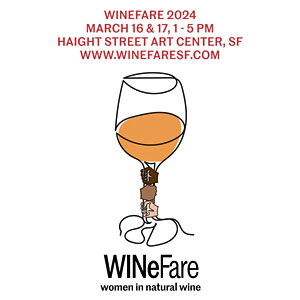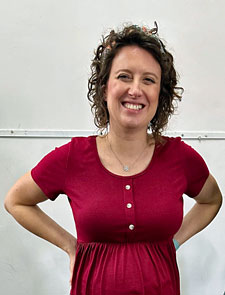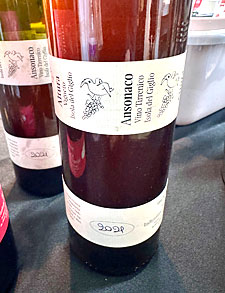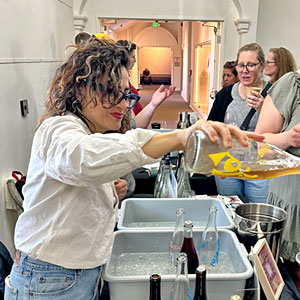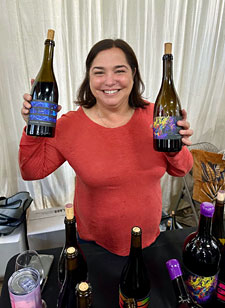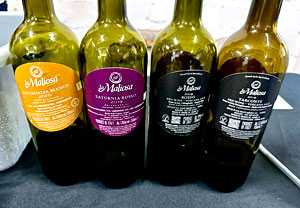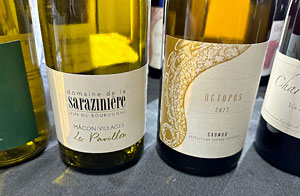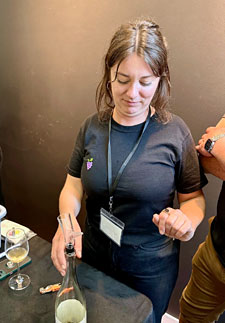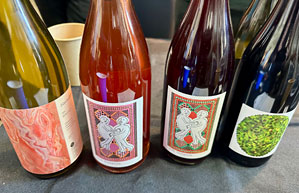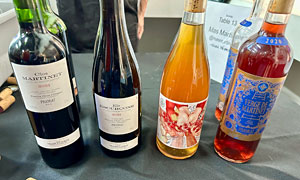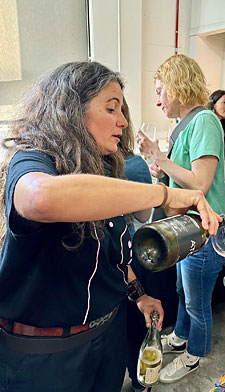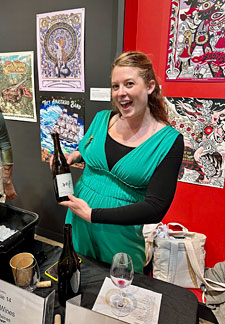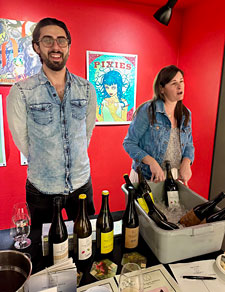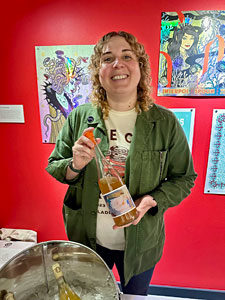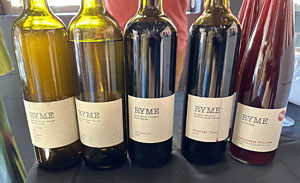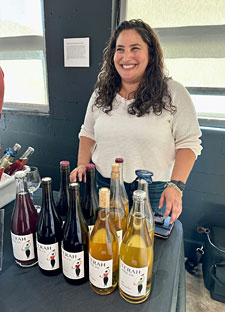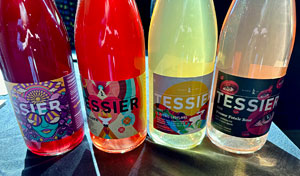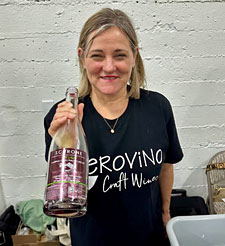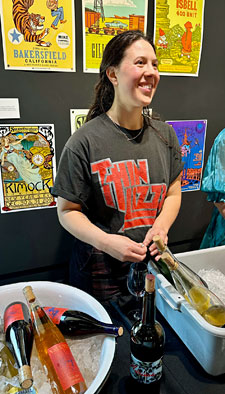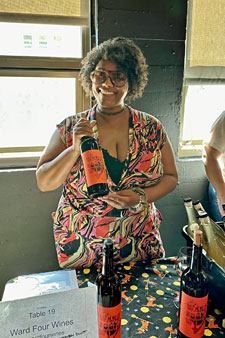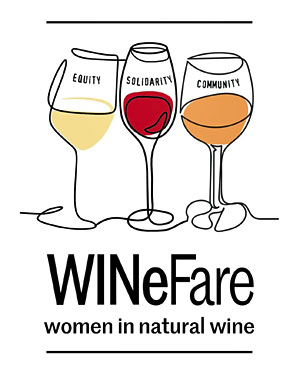Sixth WINeFare – March 17th, 2024
Report on the sixth WINeFare wine tasting, held on the afternoons of Saturday and Sunday March 16-17, 2024 at the Haight Street Art Center in San Francisco, California. The focus of the event is on women in the natural wine movement. I was able to attend the Sunday tasting and my report is on the wines poured on that day.
In addition to the two afternoon tastings, there was a winemaker dinner, two forums each morning featuring winemakers, growers, and others, plus a silent auction featuring wine selections, gift certificates, and wine-tasting experiences. This year wines from various producers were also available for sale at the event. There were also a number of WINeFare-related tastings at wine shops and wine bars in the Bay Area in the days leading up to the weekend.
WINeFare – the name stands for Women in Natural Wine – was founded in 2018 by Pamela Busch. Pamela is a longtime wine industry veteran. In 1994 she opened Hayes and Vine, one of San Francisco’s first wine bars, and in 2005 she opened CAV Wine Bar & Kitchen, one of the first natural wine venues in the Bay Area. She’s taught at several wine schools, written about wine, and currently runs The Vinguard organization and website. In conjunction with her work in wine, she has long been an advocate for equity and social justice, and the combination of these interests is the primary focus of WINeFare. Pamela has recently launched a couple of additional programs related to worker’s rights and social justice as well.
Unlike most consumer tasting events, WINeFare does not charge wineries and importers to pour, which helps make it a more inclusive event that even tiny producers pouring their first vintage can afford. Proceeds from WINeFare go to The Vinguard, a 501c3 organization whose mission is to promote a culture in the wine industry centered around ecological farming, belonging, empowerment, and equity.
General Impressions:
Some Favorites |
Sparkling and Still Whites and Rosés
Accenti 2022 “Orange Flamingo” Amber Wine of Verdelho
Belong 2022 “Chasing the Sunset” Rosé
Geyerhof 2019 Riesling “Kirchensteig” (Danch & Granger)
Isa 2022 “You’re a Dream”
Lucy Chilvers 2022 “Flor de Maeve” Xarel·lo
Mas Martinet 2022 “Pesseroles Brisat”
Nuria Renom 2021 “La Maca Vella” Macabeu
Quercia Scarlatta 2021 “Marchese Japo” (Vero Vino
Raft 2022 “Cavaillon”
Ruby Blanca 2022 Skin-Fermented Ribolla Gialla
Ryme 2022 Fiano
Terah 2022 Falanghina
Thomas Niedermayr 2018 Bronner (Rock Paper Scissors)
Virgo Magic 2021 “Disco Lemonade” Riesling
Reds
Aprés Glou 2021 Refosco (Raft / Rock Juice)
Belong 2019 Mourvèdre
Cary Q 2023 “Crazy/Perfect” Cinsault
Edith and Ida 2023 Cinsault (Hobo)
Isa 2022 “Don’t Quit Your Day Job”
Martha Stoumen 2021 Ricetti Vineyard Carignan
Sziegl 2022 “Bábel” (Danch & Granger)
Ryme 2022 Cabernet Franc
Tessier 2022 “Day Dreaming”
Var e Vem 2022 “The End is Infinite”
Ward Four 2022 Petite Sirah
Others of Note
Altura 2021 Ansonaco
Austral 2022 “Octopus” (Floraison)
Cary Q 2022 “Hollis” Mourvèdre
Fattoria La Maliosa 2018 Rosso
Folk Machine 2022 Carignane (Hobo)
Homoky Dorka 2020 “Hetény” (Danch & Granger)
Martha Stoumen 2022 “Post-Flirtation Red”
Mas Martinet 2021 “Clos Martinet”
Raft 2021 Nero d’Avola
Ruby Blanca 2022 Barbera
Ryme 2018 Aglianico
Tessier 2022 “Femme Fatale” Rosé
|
|
I missed last year’s WINeFare as I was out of town, so I was happy to return this year. This was the third year that the event has been held at the Haight Street Art Center in San Francisco. Overall it’s a very good location for the tasting with easy public transit access. About half of the producers tables were set up in several connecting rooms on the main floor level and half in a larger space on the top floor of the building.
There were over 75 producers and importers on hand to pour at this year’s event, nearly double the number from two years ago. It’s great that WINeFare has been so successful, and to accommodate the larger number of participants at the Haight Street Art Center, the tastings expanded to two days this year. I was only able to make it to the Sunday tasting so unfortunately I missed quite a few people who poured on Saturday, but there were nearly 40 producers and importers on hand Sunday so there was a very good and diverse selection of wines to try that afternoon.
As mentioned above, there were two forums presented late in the morning on each of the two days of the event, on Vineyard Worker Protections, Wine and Climate Change, Regenerative Viticulture, and Winemaking in Catalonia. I attended the Regenerative Viticulture forum, which include panelists Antonella Manuli of Fattoria La Maliosa, Brenae Royal of Monte Rosso Vineyard, and Erin Rasmussen of American Wine Project, and moderated by Chris Renfro of the 280 Project. While I won’t get into details of the discussions during the forum, the information presented by each of the panelists was very interesting, from several different viewpoints, and the moderator had insightful questions and kept everything moving along smoothly – a very worthwhile start to the day.
The event staff and volunteers ensured that everything ran very smoothly – check-in was quick and easy, there were spit cups provided, and each table had water and dump buckets that were filled or emptied regularly. These seem like basic things, but you definitely appreciate them after attending some events where they aren’t handled as they should be. Overall, this was an exceptionally well-run event.
The WINeFare website notes that to participate in the event, a company “must be at least partially women-owned, and she must play an active role in its management.” There are also requirements related to fair labor practices and to inclusiveness and empowerment of groups of people who are too often marginalized by the wine industry (as well as by society in general).
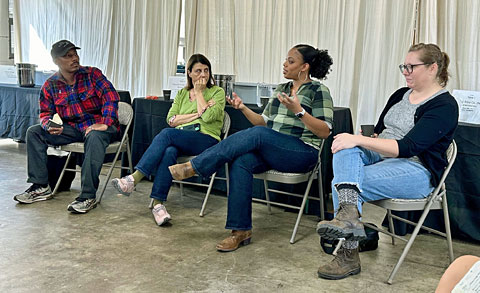 |
| Wine Seminar at WINeFare |
Wines poured at the event must be from hand-harvested fruit, with farming at minimum practicing organic, made with native fermentation, no sterile filtration or similar practices (bentonite fining is acceptable), and no additions other than SO2 (with no set limit but intended to be as little as winemakers feel is needed). That’s a pretty straightforward yet relatively lenient and inclusive definition, which allows wines that would not be accepted at some other natural wine tastings. It should be noted that not all of the wineries and importers at WINeFare typically promote themselves and their wines as natural – calling them minimal intervention might work just as well for much of the wine poured at the event.
I made it to 24 winery and importer tables this year’s WINeFare and tasted about 90 wines. On this occasion, I tasted every wine being poured at most of the tables I got to, so I didn’t get to quite as many tables as on my last time at the event. It should be noted that the wines listed in my notes below are by no means the only ones I tasted, but I felt that these were the most noteworthy ones at each table. Producers ranged from some fairly well-established ones to newer ones that have received well-deserved positive press, to little-known – and some brand-new – wineries. In addition to wine, the tasting featured a few ciders but I passed on those in order to stay more focused.
I missed out on some of the wineries and importers I’ve really enjoyed in the past who were pouring on Saturday this year, but that allowed me to check out more wineries on Sunday that were either entirely new to me or ones that I’d hadn’t tried in recent years. In my notes below, I’ve tried to focus on the wines from each winery and importer that made the biggest impressions on me, but it doesn’t necessarily mean that I didn’t like other wines at their tables as well.
Overall the wines I tasted at this year’s WINeFare were very clean, with most not showing much of the “natty” character that has often divided those who like or dislike natural wines. And wineries and importers at this tasting presented the best group of skin-contact white wines I’ve tried, by far. In fact, I’d say my wine of the day was the 2022 Skin-Fermented Ribolla Gialla from Ruby Blanca, a producer that was new to me.
Favorite wineries and importers at the tasting included Belong, Cary Q, Danch & Granger, Hobo, Isa, Raft, Ruby Blanca, Ryme, Tessier, and Ward Four, with several others such as Accenti, Martha Stoumen, Mas Martinet, Rock Paper Scissors, Terah, Var e Vem, and Virgo Magic being nearly as impressive. As with my previous times at WINeFare, it was tough to pick out wines for my “Favorites” list since there were a number of others that were tempting to add, but I had to stop somewhere.
WINeFare continues to do a great job of showcasing the skill, creativity, and enthusiasm of women in the natural wine movement. The event is always a lot of fun, and I enjoy discovering producers and wines that are new to me. As natural wines continue to improve – as shown in this tasting – there’s less and less reason to look at them as something separate, as only a niche market. The best natural wines – including many poured at WINeFare – have a deservedly growing place in the overall wine world. WINeFare as an organization certainly goes far beyond just tasting wines that women in natural wine have produced, but this event is a key part of it and I look forward to attending again next year.
Selected Tasting Impressions |
Accenti / Thereafter Wines
Accenti and Thereafter are the labels of Lorenza and James Allen, and they make their wines in Santa Rosa. Their first vintage was in 2018, and they work with regenerative and organic methods in the vineyard and minimal-intervention winemaking in the cellar. I particularly liked their bright and citrusy 2021 Verdelho from Contra Costa County as well as their 2022 “Orange Flamingo” Amber Wine of Verdelho – made with two days of skin contact, this had a nice balance of stone fruit notes and phenolic skin-contact character, with great texture.
Altura
Gabriella and Francesco Carfagna are the proprietors of Altura, which showcases wines from their vineyard on the Isola del Giglio off the coast of Tuscany. My favorite wine at their table was the 2021 Ansonaco –a white grape variety more often known as Inzolia – that was fermented on the skins for one week. Deeply colored, this had lots of spice and fresh herb aromas with mild tannins on the finish.
Azizam Wines
Maryam Hariri, who works with Bichi Wines, has her own Azizam label, also focusing on wines sourced from Baja California. I thought the bright and floral 2023 Pét-Nat Moscatel from coastal Ensenada region of Baja California was the standout at her table.
Belong Wine Co.
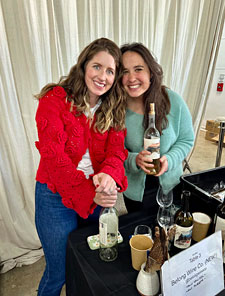 |
| Belong - Alli Van Zyl and Ali Huerth |
Alli van Zyl and her husband Bertus are the team behind Belong, which they started in 2017. The wines are made in Napa, and they work mainly with Rhône grape varieties grown in El Dorado County – the three wines at their table were from El Dorado and I liked all of them. The light and floral 2022 “Chasing the Sunset” Rosé – from about 50% Mourvèdre and 25% each Cinsault and Grenache – also had notes of stone fruit and spice, while the 2022 “Sunshower” Carbonic Red, entirely from Mourvèdre, was another bright and light wine with red fruit and herb aromas. The 2019 Mourvèdre was a classic El Dorado rendition of this variety, featuring red fruit, earth, stony minerals, and iron, with great structure.
Cary Q Wines
Cary Quintana is the owner / winemaker of her Cary Q label – she launched the winery in 2014 and currently makes her wines in Santa Rosa. Much of her fruit is sourced from the Sierra Foothills. I particularly enjoyed three wines that she poured, starting with the 2021 “Cosmic Dance” Grenache-Syrah blend from Shake Ridge Ranch in Amador County – this had bright red fruit with spice and earth undertones and great acidity. The 2023 “Crazy/Perfect” Cinsault from Fenaughty Vineyard in El Dorado County featured loads of juicy upfront red and darker berry fruit with a vibrant texture and finish. The bright and minerally 2022 “Hollis” Mourvèdre from Shake Ridge Ranch was another winner and should develop nicely with cellaring.
Danch & Granger Selections
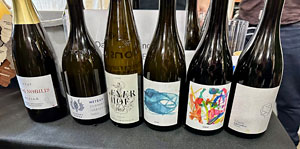 |
Eric Danch and Catherine Granger founded their import company in 2019 following the retirement of the owners of Blue Danube Wine Co. where they both worked, and they continue Blue Danube’s focus on the wines of Central and Eastern Europe. Both Catherine and Eric were on hand at the tasting, and I especially liked four of the wines they poured. The bright and citrusy Homoky Dorka 2020 “Hetény” is a blend of Furmint and Hárslevel? from Tokaj in Hungary, direct pressed and made in stainless steel. A Furmint sparkling wine from Tokaj, the Tokaj Nobilis 2018 “Pezsgo Brut” was light and refreshing. The Geyerhof 2019 Riesling “Kirchensteig” from the Kremstal region of Austria featured bright tropical and stone fruit aromas with a touch of petrol and a lively texture. A blend of mostly co-fermented Kékfrankos, Zweigelt, and Cabernet Sauvignon from the Hajós-Baja region of Hungary and pressed after short skin contact, the Sziegl 2022 “Bábel” was very light, with both red and stone fruit aromas, bright acidity and fine structure.
Fattoria La Maliosa
Run by Antonella Manuli, Fattoria La Maliosa is a 160-hectare farm in Tuscany that has produced winegrapes, olive oil, and honey since 2009. The farming is certified organic. My favorite at this table was the 2018 Rosso, a blend of Ciliegiolo and Cannonau Gris from Tuscany, with savory, earth, and smoky aromas and a lively texture.
Floraison Selections
Floraison Selections was founded in 2017 by Nadia Dmytriw, who has worked in the wine industry since 2001. Importers and distributors, they represent French producers from a number of regions. I particularly enjoyed two wines at her table, starting with the Domaine de la Sarazinière 2021 “Le Pavillion” Chardonnay from Mâcon-Villages – medium bodied, this had pear and spice notes with floral undertones. The Austral 2022 “Octopus” – Chenin Blanc from Saumur in the Loire Valley – featured a brighter and more citrusy character with a vibrant finish.
Hobo Wine Company
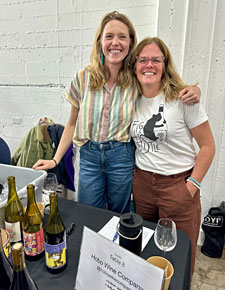 |
| Hobo - Kelsey Freeman and Lynn Wheeler |
Run by Lynn Wheeler and Kenny Likitprakong and based in Santa Rosa, Hobo Wine Company is home to a number of well-known labels including Hobo, Ghostwriter, and Folk Machine among others. The Edith and Ida 2023 Cinsault – from Lynn’s own label lanched in 2014 – comes from Mendocino fruit that was whole-cluster fermented, displaying bright red fruit and herb notes with hints of flowers and fine structure. The Folk Machine 2022 Carignane from Redwood Valley had earthy red fruit and spice aromas with a chalky mineral texture and lively finish.
Isa Wines
Originally from Italy, Isabella Morano came to California after finishing high school, and she worked as a sommelier and at several well-regarded wineries before starting her own label. I enjoyed all three wines that she poured and thought two in particular were standouts. The 2022 “You’re a Dream” skin-contact Sauvignon Blanc from Ascona Vineyard in the Santa Cruz Mountains spent about two days on the skins prior to pressing, and displayed a great balance of bright citrus and stone fruit plus phenolic skin-contact character. The 2022 “Don’t Quit Your Day Job” Mataro blend, mostly Mataro from Amador County plus a little Grenache, Syrah, and more Mataro from Sonoma Valley, was whole-cluster fermented and had bright and savory red fruit aromas plus spice and iron notes, with a lively mouthfeel and great structure
Lucy Chilvers Wines
Lucy Chilvers is from the UK, and after earning a degree in viticulture and enology and working for a time in Italy, she moved to Catalonia, where she sources her fruit and makes her wines. My favorite at her table was the 2022 “Flor de Maeve” Xarel·lo from Penedès in Catalonia – this spent two weeks on the skins, and is entirely from free-run wine. This featured a spicy and earthy profile with a lively, minerally texture.
Martha Stoumen Wines
Martha Stoumen released the first wines from her eponymous label in 2017, after working for notable producers in California, Italy, France, Germany, and New Zealand. I especially enjoyed both red wines at her table, beginning with the 2022 “Post-Flirtation Red” – a blend of mainly Zinfandel and Carignan, this was bright and lively, with plum, spice, and earth aromas. The 2021 Ricetti Vineyard Carignan from Redwood Valley featured a darker and earthier character, with a firm tannic finish – this should benefit from a few years of cellaring.
Mas Martinet
The Pérez family established Mas Martinet in Priorat in 1981, and their vineyard has been certified organic since 2009. Winemaker Sara Pérez poured her wines at the tasting, and I thought two of them were particular highlights. The 2022 “Pesseroles Brisat” blend of Picpoul, Grenache Blanc, and Pedro Ximinez, fermented on the skins for three weeks and made in stainless steel, displayed stone fruit and orangepeel aromas, with a lively and slightly chalky texture and moderate tannic grip on the finish. A blend of mostly Grenache, Carignan, and Syrah, the 2021 “Clos Martinet” was fermented in concrete and aged mostly in concrete – earthy red and black fruit plus spice, with a bigger texture and firm tannins, this showed lots of promise for further development with cellar aging.
|
Nuria Renom
Originally from Argentina, Nuria Renom moved with her family to Spain when she was a child. After working as a sommelier and at vineyards and wineries, she started her own wine project in 2021. She was on hand at the tasting, and my favorite wine at her table was the 2021 “La Maca Vella” Macabeu from 80-year old vines at her vineyard in the Penedès region of Catalonia. This had four-day skin contact and was made entirely from free run juice – pear, stone fruit, and spice aromas with medium weight and a lively texture on the palate.
Raft Wines
Jennifer Reichardt launched her Raft label in 2016, after working harvest / crush in both the northern and southern hemispheres. She makes her wines in Sonoma County, and her vineyard sources range from the Sierra Foothills to Sonoma and Mendocino counties. I thought three of her wines were standouts, beginning with the 2022 “Cavaillon,” a skin-contact Sauvignon Blanc from Mendocino County, with citrus and stone fruit, spice, and fresh herb aromas and a nice mouthfeel. A collaboration with Melissa Modanlou of Rock Juice, the Aprés Glou 2021 Refosco, from Saureel Vineyard in El Dorado County, was foot-trod and then pressed early – this had bright and light black cherry and plum fruit, spice, and a juicy texture. The 2021 Nero d’Avola, also from Saureel Vineyard, was bolder, with more dark fruit and spice, a bigger mouthfeel, and firm tannins – a good candidate for mid-term cellaring.
Rock Paper Scissors Wine Imports
Rock Paper Scissors was established in Napa Valley in 2019 by Ashley Taranto and Federico Parlagreco. All four wines they poured at the tasting were made by Thomas Niedermayr, from Alto Adige. These all featured “PIWI” varieties from Europe that are hybrids of vitis vinifera and North American varieties, created to be resistant to fungus and other issues. A favorite was the Thomas Niedermayr 2022 “Freistil,” a Pét-Nat from Bronner, Solaris, and Souvignier Gris – lightly sparkling, with bright pear and earth and fine acidity. The Thomas Niedermayr 2018 Bronner was another highlight, with lots of upfront stone fruit aromas and a medium-rich texture.
Ruby Blanca Wines
Sabrina Tamayo worked at several wineries for harvest / crush before launching her Ruby Blanca label in 2021, and she makes her wines in Richmond, California. I thought two of her wines at the tasting, both sourced from Il Mio Vigneto Vineyard in the Clements Hills region of Lodi, were highlights. The 2022 Skin-Fermented Ribolla Gialla had pear and stone fruit, savory herbs, and lots of spice notes, a lively medium-bodied texture, and a fine chalky mineral character on the finish. Made from both destemmed and carbonic lots, the 2022 Barbera had bright cherry and herb aromas with earthy undertones, a lively mouthfeel and juicy finish.
Ryme Cellars
Megan & Ryan Glaab founded Ryme Cellars in 2007, and they make their wine in Forestville. Both Megan and assistant winemaker Matt Crutchfield were on hand at the tasting. They poured a strong lineup and I thought four of their wines were standouts. The 2022 Fiano from Rancho Coda in Russian River Valley was whole-cluster pressed and then aged in neutral oak, and displayed bright citrus and pear aromas with a touch of spice and a minerally texture. The carbonically-fermented 2022 Sangiovese Friulano includes 9% Friulano and had upfront floral and cherry aromatics with a very lively mouthfeel. Sourced from Alegría Vineyard in Russian River Valley, the 2022 Cabernet Franc was whole-cluster fermented, and showed fresh herbal and floral notes, plummy fruit, with good structure. The 2018 Aglianico from Luna Matta Vineyard in Paso Robles featured dark berry fruit plus touches of flowers and black pepper, with a grippy tannic finish.
Terah Wines
A certified sommelier as well as a winemaker, Terah Bajjalieh worked in the restaurant business, wine education, and over a dozen winegrape harvests in California, Oregon, France, Argentina, Australia, and New Zealand. She launched her wine label in 2020. I especially liked two of her wines, starting with the 2022 Sparkling from the Central Coast and made from about 50% Chardonnay plus Pinot Noir and Muscat – stone fruit, citrus, and floral aromas, with a lightly sparkling texture. The 2022 Falanghina from Clarksburg spent 12 days on the skins prior to pressing – it had a nice balance of peach fruit and phenolic skin character, with a great texture and finish.
Tessier Winery
Tessier owner / winemaker Kristie Tacey has a background as a research scientist, and she established the Tessier label with the 2009 vintage. She makes her wines in Berkeley and produces a number of varietal wines and blends. I enjoyed all of the wines that Kristie poured at the tasting, and I thought that three of them particularly stood out. The 2022 “Femme Fatale” Rosé, from Central Coast Grenache and Pinot Noir, displayed floral, tropical fruit, and red fruit aromas with a vibrant mouthfeel and finish. The 2022 “Electric Ladyland” is a skin-contact blend of mostly Albariño plus Chardonnay, Pinot Gris, Riesling, Grenache, and Pinot Noir – this had more of a citrus and apple profile, with fine acidity. One of the newer Tessier blends is the 2022 “Day Dreaming,” mostly Négrette and Mourtaou along with some Riesling, all from the Central Coast – black cherry and plum plus spice and floral undertones with a lively texture, this had a moderately tannic finish.
Var e Vem
Ully Pòvoa was born in Brazil but grew up in California, and founded her Var e Vem (“Come and Go” in Portuguese) label in 2021. She makes her wine in Sonoma. Two of her wines were highlights, starting with the 2022 “Psycosphere” Picpoul from Lodi, featuring bright citrus fruit with great acidity and mouthfeel. The 2022 “The End is Infinite,” Petit Verdot from Lodi was made using an unusual method – the fruit was placed in large plastic bags and sealed for three weeks, then opened and drained for free run wine only. The wine was quite floral, with dark berry fruit and moderate tannins.
Vero Vino Craft Wines
Sommelier Sheila Donahue lived in Italy for 20 years before returning to the US and founding Vero Vino. Not surprisingly, many – though not all – of the producers she represents are from Italy. My favorite wine at her table was the Quercia Scarlatta 2021 “Marchese Japo” white blend from Le Marche in Italy, with bright and floral stone fruit aromas, medium weight on the palate, and a lively finish.
Virgo Magic Wines
Olivia “Liv” Ross worked at several noted wineries after earning a degree in viticulture and enology and before launching her Virgo Magic label in Berkeley in 2020. I thought two of her wines were standouts. The 2021 “Disco Lemonade” Riesling from old vines at Wirz Vineyard in Cienega Valley displayed petrol, citrus, and stone fruit with vibrant acidity. The spicy, earthy, and red-fruited 2021 “Adriana” Montepulciano from Siletto Vineyard in San Benito County had a lively texture and moderate tannins.
Ward Four Wines
Justin Michelle Ward Trabue is from Washington DC and she started her Ward Four label after working harvest / crush for a number of wineries in Australia and the US as well as earning a wine business degree. She makes her wine in Sonoma, and I enjoyed both wines she poured at the tasting. A barrel sample of 2023 Muscat Blanc, sourced from Contra Costa County and fermented on the skins for nine days, had a great mouthfeel with toned-down Muscat aromatics due to the skin fermentation. The 2022 Petite Sirah from Grist Vineyard in Dry Creek Valley featured floral aromas along with dark berry fruit, with fine acidity and moderate tannins on the finish.
|
|
|


